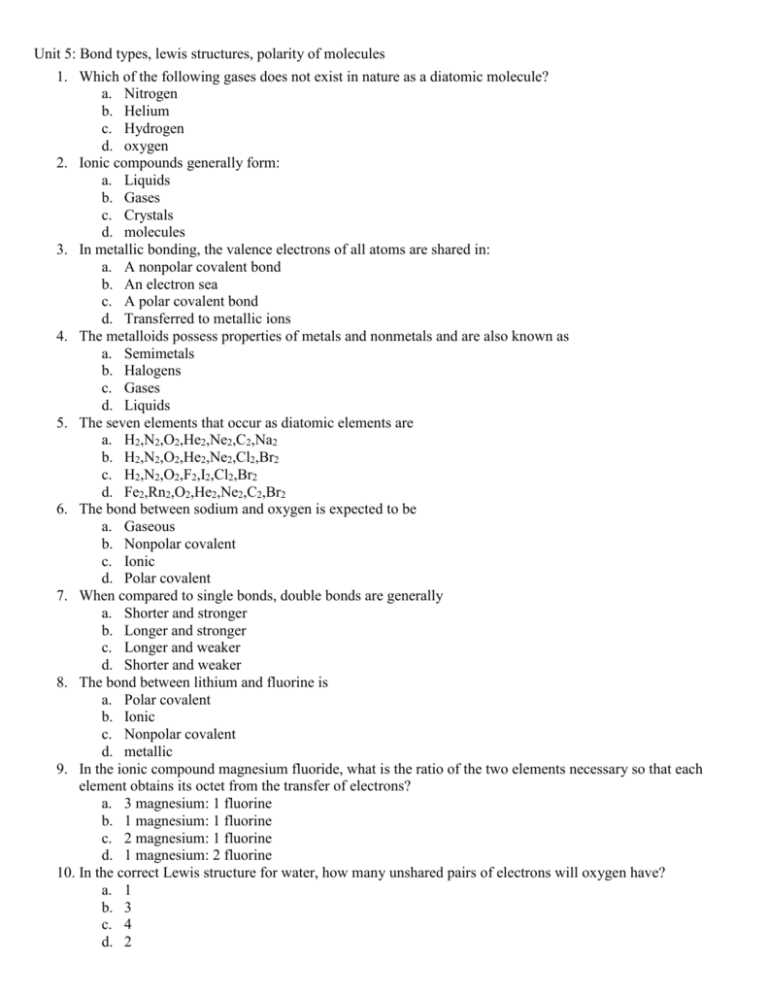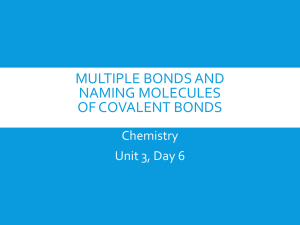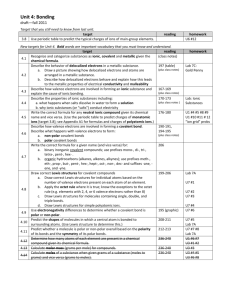Unit 5 Midterm Review Packet - MPHS Standish 2
advertisement

Unit 5: Bond types, lewis structures, polarity of molecules 1. Which of the following gases does not exist in nature as a diatomic molecule? a. Nitrogen b. Helium c. Hydrogen d. oxygen 2. Ionic compounds generally form: a. Liquids b. Gases c. Crystals d. molecules 3. In metallic bonding, the valence electrons of all atoms are shared in: a. A nonpolar covalent bond b. An electron sea c. A polar covalent bond d. Transferred to metallic ions 4. The metalloids possess properties of metals and nonmetals and are also known as a. Semimetals b. Halogens c. Gases d. Liquids 5. The seven elements that occur as diatomic elements are a. H2,N2,O2,He2,Ne2,C2,Na2 b. H2,N2,O2,He2,Ne2,Cl2,Br2 c. H2,N2,O2,F2,I2,Cl2,Br2 d. Fe2,Rn2,O2,He2,Ne2,C2,Br2 6. The bond between sodium and oxygen is expected to be a. Gaseous b. Nonpolar covalent c. Ionic d. Polar covalent 7. When compared to single bonds, double bonds are generally a. Shorter and stronger b. Longer and stronger c. Longer and weaker d. Shorter and weaker 8. The bond between lithium and fluorine is a. Polar covalent b. Ionic c. Nonpolar covalent d. metallic 9. In the ionic compound magnesium fluoride, what is the ratio of the two elements necessary so that each element obtains its octet from the transfer of electrons? a. 3 magnesium: 1 fluorine b. 1 magnesium: 1 fluorine c. 2 magnesium: 1 fluorine d. 1 magnesium: 2 fluorine 10. In the correct Lewis structure for water, how many unshared pairs of electrons will oxygen have? a. 1 b. 3 c. 4 d. 2 Unit 5: Bond types, lewis structures, polarity of molecules 11. In the correct Lewis structure for the methane molecule, how many unshared electron pairs surround the carbon? a. 2 b. 0 c. 8 d. 4 12. In nonpolar covalent bonds, valence electrons are a. Equally shared b. Unequally shared c. Destroyed d. transferred 13. Which of the following is an acceptable Lewis structure for chloromethane (CH3Cl)? a. b. c. d. 14. In a diatomic molecule of an element, the bond between the atoms must be a. Nonpolar covalent b. Polar covalent c. Metallic d. ionic 15. In polar covalent bonds, valence electrons are a. transferred b. unequally shared c. destroyed d. equally shared Unit 5: Bond types, lewis structures, polarity of molecules 16. In ionic bonds, valence electrons are a. Equally shared b. Transferred c. Unequally shared d. destroyed 17. How many atoms are needed to provide the electrons necessary to complete the valence octet of an oxygen atom? a. Three sodium atoms b. Two sodium atoms c. Four sodium atoms d. One sodium atom 18. The measure of the attraction that an atom has for electrons involved in chemical bonds is known as a. Ionization energy b. Radioactivity c. Electronegativity d. Electron affinity 19. Which of the following is the correct Lewis structure for ammonia? a. b. c. d. 20. In drawing Lewis structures, a single line (single bond) between two elements represents a. An octet of electrons b. An unshared pair of electrons c. A shared electron d. A shared pair of electrons 21. Which of the following is a correct Lewis structure for hydrogen cyanide, HCN? a. b. c. d. Unit 5: Bond types, lewis structures, polarity of molecules 22. Which of the following is the correct Lewis structure for formaldehyde, CH2O a. b. c. d. 23. Which of the following is the correct Lewis structure for phosphorus tribromide? a. b. c. d. 24. Which of the diatomic elements has a double bond between its atoms? a. Fluorine b. Nitrogen c. Oxygen d. Hydrogen







